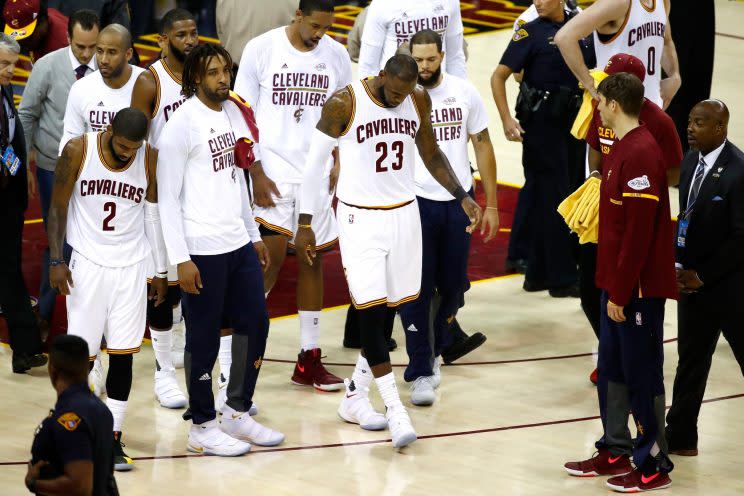Summer agenda: Can Cavs close the gap on Warriors?
The Vertical Front-Office Insider Bobby Marks, a former 20-year executive with the Nets, looks at the possible offseason plans and roster details for every team in the league.
Previous teams in the series: Nets and Suns | Timberwolves and 76ers | Magic and Kings | Hornets and Pelicans | Knicks and Nuggets | Lakers and Heat | Mavericks and Pistons | Pacers and Blazers | Hawks and Thunder | Bulls and Grizzlies | Clippers and Bucks | Raptors and Jazz | Spurs | Rockets and Wizards | Celtics
CLEVELAND CAVALIERS
Offseason focus
Improving the bench
For most of the season, Cleveland’s roster resembled that of a team built for the postseason.
A lack of experience at backup point guard and an injury to shooting guard J.R. Smith exposed Cleveland’s lack of depth for most of the season.
The additions of Kyle Korver in January and former All-Star Deron Williams in early March improved the Cavs’ reserve unit.
Now with Korver and Williams set to enter free agency, GM David Griffin faces the challenge of rebuilding the bench with limited resources.
[Yahoo Store: Get your Golden State Warriors championship gear right here!]
While Cleveland has Korver’s Bird rights, re-signing the 36-year-old comes at a significant cost because the Cavaliers are a repeater tax team.
Cleveland would likely have to use part of its $5.2 million tax mid-level exception for Williams.
If both players leave, Cleveland would have the tax mid-level exception and minimum contracts to use.
With Iman Shumpert, Richard Jefferson, who turns 37 in five days, and 34-year-old Channing Frye as the lone key reserves under contract, Cleveland’s bench could resemble the struggling unit from last season but a year older.

The repeater tax
Cleveland, for a fourth straight season, will be in the luxury tax.
Unlike last season, when the Cavaliers paid a tax of $24.8 million, the 2017-18 season could come at a steep cost.
Because Cleveland was in the tax the previous three seasons and already with $125 million in salary ($4 million above the tax), it will be considered a repeater tax team in 2017-18.
The Cavaliers, with a projected $12.5 million tax bill next season, will see that number grow as they rebuild their bench.
If the Cavaliers bring back Korver at an $8 million salary, sign a player to the $5.2 million tax mid-level and round out their bench with minimum contracts, the tax bill will grow from $12.5 million to $84 million.
Cleveland would now be considered a Tier 5 tax team because they are $24 million over the tax line.
Any additional cost of $1 million or more would make Cleveland a Tier 6 tax team.
Breaking down the repeater tax
Tier Tax level Tax rate
1 $0–$4,999,999 $2.50-for-$1
2 $5,000,000–$9,999,999 $2.75-for-$1
3 $10,000,000–$14,999,999 $3.50-for-$1
4 $15,000,000–$19,999,999 $4.25-for-$1
5 $20,000,00–$24,999,999 $4.75-for-$1
6 $25,000,000–$29,999,999 $5.25-for-$1
The Cavaliers’ tax bill would be $53 million if Korver does not return and the tax mid-level and minimums are used to round out the bench.
The tax and salary commitment to bring back Korver at an $8 million contract would be $40 million.
The resources to improve
The Cavaliers’ hands are tied in how they address their roster needs.
The Cavaliers also will need to take a back seat as the draft approaches.
Cleveland does not have a first- or second-round pick and doesn’t have available cash to buy a pick in the draft. Cleveland also can’t trade a first-round pick until 2021, at the earliest.
The Cavs’ improvement will come from the pool of undrafted players, in free agency or via trades.
The Cavaliers possess three trade exceptions: $4.8 million, $2.2 million and $1.3 million. The three exceptions cannot be combined to acquire multiple players.
Each trade exception comes at a cost because of the Cavaliers’ tax situation.

Summer cap breakdown
Guaranteed 2017-18 Insider info
LeBron James $33,285,709 No-trade clause
Kevin Love $22,642,350
Kyrie Irving $18,868,626 Trade bonus
Tristan Thompson $16,400,000
J.R. Smith $13,760,000
Iman Shumpert $10,337,079 Extension eligible
Channing Frye $7,420,912 Extension eligible
Richard Jefferson $2,500,000
Non/partial 2017-18 Guarantee date
Kay Felder $1,312,611
Edy Tavares $1,471,382
FA cap hold 2017-18 FA status
Kyle Korver $9,954,930 Bird
Deron Williams $1,471,382 Non-Bird
Derrick Williams $1,471,382 Non-Bird
James Jones $1,471,382 Non-Bird
Dahntay Jones $1,471,382 Non-Bird
Salary table 2017
Guaranteed salaries $125,671,305
Non-guaranteed $1,920,102
Free-agent cap holds $15,840,458
Salaries: cap $143,431,865
Salaries: tax $127,591,407
Salary cap $101,000,000
Luxury tax $121,000,000
Cap space None ($42,431,865 over)
Tax room None ($6,591,407 over)
Projected cap space
The Cavaliers do not have cap space and will be a luxury-tax team next season.
Cleveland has the $5.2 tax-mid level exception to use along with the minimum exception.
June draft picks
Cleveland sent Portland its first-round pick, and the Celtics have the Cavaliers’ second-round pick.
Cleveland also doesn’t have money to use at the draft to buy a second-round pick.
The Cavs’ $3.5 million allotment was used in part of four separate trades.
Future draft picks
The Cavaliers will send Atlanta a first-round pick in 2019, protected Nos. 1-10.
The protection will carry over to 2020, protected Nos. 1-10.
If the pick is not conveyed by 2020, Cleveland will send Atlanta second-round picks in 2021 and 2022.
The Cavaliers cannot trade a first-round pick until two years after Atlanta receives its first-rounder.
Popular video from The Vertical:

